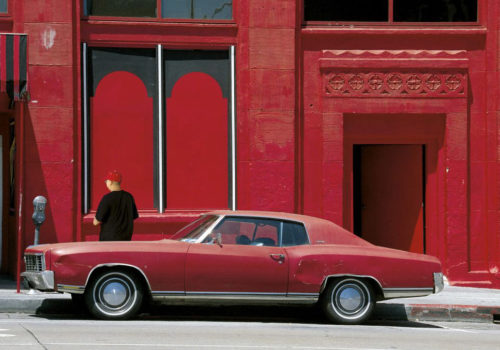Bodies like landscapes, hills and planes with anthropomorphic outlines that unequivocally state the visual language of Franco Fontana. “Bright, vibrant colours; a rhythm set by overlapping lines and planes, geometrical shapes built by the light; hyper-real landscapes, true and surreal at one time”, Denis Curti, curator of the exhibition at Istituto Veneto di Scienze, Lettere ed Arti in Venice, says. More than 130 pictures dealing with the stunning impact of the palette of a photographer who in the 1960s started as amateur and in the 1970s became an internationally well-known professional. The several thematic sections of the exhibit reflect the various interests in his photographic career.
Often photography is considered a faithful documentation of facts. Franco Fontana, instead, thinks that, as a subjective eye, it bends reality with the tools of the photographic language. His images are absolute abstraction, but, paradoxically, they are also a plain record of reality, without any processing techniques or manipulations: as Fontana says, “everything is already available in the vast scenery of the world.”
He was among the first in Italy to use colour as “message”. “Deceptive proportions with no room for humans. Figures revealed in negative, sublimated in long shadows suggesting the idea of both presence and absence. He uses the photographic medium to capture not only the reality, but also the world beyond the “facts” Curti (who is also the artistic director of the Casa dei Tre Oci in Venice) adds.
“I try to isolate what usually gets lost in manifold particulars. This work of extracting some essential elements from the complexity in front of the human eye, corresponds to my inner need, finding a harmonious unity by erasing all disturbing elements”, Fontana explains.
In 1963 he made his international debut at the Third International Colour Biennial in Wien and in 1968 he held his first solo in Modena. Then a book “Modena, una città” and other solo exhibits in Ferrara and at the Diaframma in Milan, with his first studies on landscape.
More books followed – among them, Skyline (1978) – which convey his thoughts on “a subjectively interpreted landscape as the interaction among light, colour and space-mass. It was a non-descriptive, anti-naturalistic development of colour, close to a synthetic feel (…) following the idea that “photography must not reproduce the visible, but make the invisible visible. Invention, imagination and interpretation are key tools in seeing the landscape in a new, non-conventional way”, Curti says.
These elements are within a photo Fontana shot in 1978 at Baia delle Zagare, that was to become one of the iconic images in his career, a clean-cut composition, played out in few concise hues and bands of colour. It was used for a campaign by the French Ministry of Culture.
People are almost absent in Fontana’s images. The first human elements are in the series Presenza Assenza (“Presence Absence”; 1979-1982), mostly with a metaphysical feel, an ephemeral dimension. In 1979 Fontana embarked on the first of a long series of trips to the United States, where he simply applied his own language to a different kind of urban environment. The results were “Urban Landscapes” and “American Lights”. His series include also: Piscine (Swimming Pools), featuring as co-protagonists the human body and water, Asfalti (Asphalts), and Nudi (Nudes). In the 2000s he presented Paesaggio immaginario (Imaginary Landscape), in which the images are reassembled on the computer following highly imaginative intuitions. He also took part in the Vita Nova project (New Life), for the European Week of Monumental Cemeteries.
“Photography is neither a craft nor a profession for me. It is simply the most important thing in my life, second only to the affection of my family and friends. It’s not enough to look, you must look with eyes that want to see and understand with the mind to believe in what you see. Taking photographs is an act of knowledge. What we photograph are reproductions of ourselves. The photographer dissolves in his photographs”, Fontana says, for “creative photography does not reproduce but interprets by making the invisible visible”.
Full Color is promoted by Istituto Veneto di Scienze, Lettere ed Arti in collaboration with Venezia Iniziative Culturali. It is produced by Civita Tre Venezie together with Tre Oci and Grafica Veneta. The catalogue, curated by Denis Curti is published by Marsilio Editori
EXHIBITION
Franco Fontana
Full color
February 15th – May 18th 2014
Istituto Veneto di Scienze Lettere ed Arti
Palazzo Cavalli-Franchetti
Campo Santo Stefano 2842
Venice
Italy
Opening hours: Monday – Sunday: from 10am to 19pm
Tuesday: closed
Catalogue Marsilio Editori (200 pages)
















